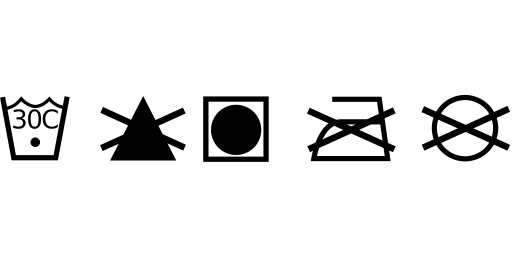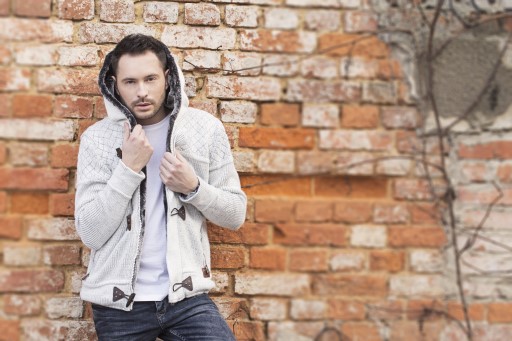- Main page
- How to launder clothes and care about them?
How to launder clothes and care about them?
Guides

How to launder clothes and care about them?
Indeed, fashion trends change every season, but don't feel obliged to go with their flow completely. It's not only the way to create your own style but also to save money. When we want to buy clothes for many seasons, beside considering the look, we should also pay attention to the quality and to proper care.
Cleaning and caring about clothes can really enhance their durability and provide a long-lasting beautiful look. For a good start, you can get familiar with information from the label. You will find there crucial details on the temperature of laundering and ironing. It's also worth checking the type of fabric, from which our clothes are manufactured. Synthetic and genuine materials differ a lot, that's why the recommendations regarding laundering, drying and ironing can vary.

Everyday caring
Everyday caring is the basic rule. Even a minimalist should have a couple of items of the same clothes in his wardrobe. Instead of wearing the same pair of jeans every day, it's better to give them 'a rest' for one or more days. The same rule applies to T-shirts, jumpers and shoes.
What should remember not to do? Air clothes out and don't put them into the wardobe right after undressing.
You won't regret organizing your wardrobe. Segregate your closets and drawers, put the hangers in one direction and hang clothes depending on their length – from the longest to the shortest. Space is important. They should hang separately and not to tightly because they are likely to get crumpled and what's worse – moths can infest there.
Hangers are very useful, remember that! Their size is important. Too small or too big can deform clothes. They have to be made from a good material and their edges have to be round. The best are wooden polished ones that don't hook delicate fabrics and look very nice.
Contrary to appearances, not all clothes should be put on hangers. Blazers, shirts, coats, jackets or dresses are to be hanged for sure. However, it's better to fold a thick woolen jumper and put it on the shelf because the gravity will do its job.
Think about getting yourself suit covers for elegant clothes like a woolen winter coat, a suit or a silk dress. This will protect them from dust and moths.
It's certainly worth buying a fabric shaver or a special cleaning roller. The first one is used for refreshing coats, jumpers and all knitwear which is likely to pill, especially in the rubbing areas. On the other hand, the roll allows you to remove all crumbs, hair and clumps quickly and successfully.
Be careful with cosmetics. Fabrics can get dirty by powder, creams or antiperspirants. Before putting on clothes, we suggest waiting until all these things are absorbed by the skin.
Laundering clothes
While doing the laundering, you should look at the recommendations of the producer, which can be found on the label. It is usually information about the type of laundering and water temperature. If there is a sign with a hand on a symbol, it means that the product requires to be hand-washed. The temperature on the symbol shows the max. washing temperature for this product.
If there is a letter P or F in a circle on the symbol, this product should be dry-cleaned. The clothes which are all about the shape should be especially applied to this rule, e.g. suit jackets, coats and jackets. Be careful when you are dealing with bleachers. You can't use them too often. Check if there is a triangle on the label – if there is, it means that using a bleacher on this product is allowed.
The most important factor regarding patterned and colourful clothes is the laundering temperature. Too high can cause colour loss or dyeing. That's why when choosing the washing program it's good to throw a colour catcher.
The effects of washing depend mostly on the detergents. You should buy the ones dedicated to white clothes as well as to colourful clothes. You can also try out special colour-saving capsules and a fabric softener that additionally gives clothes a nice smell. Be aware that softeners shouldn't be used for laundering sport clothes and thermoactive underwear. Don't overdo with detergents, we suggest getting familiar with the instructions provided by the producer. If you encounter unusually hard stains to remove, try pre-washing those clothes before you put them in the washing machine. Use hard soap to wipe the collars – especially exposed to dirt.

Clothes can be protected in the washing machine against mechanical damage. All zippers, velcros and buttons need to be fastened before throwing into the washine machine. Think also about turning the clothes inside out to protect them against dyeing and colour loss. Moreover, there are special washing nets for underwear, shoe laces, insoles and delicate materials.
The old good way to launder clothes is segregating them. It's important to group light and dark clothes, as well as to focus on the type of fabrics. If you mix clothes of different fabrics, remember to set the laundering temperature to the lowest among the labels. Don't put too many pieces to the drum. The more clothes, the worse quality of cleaning. You can also make the powder stay inside.
The most delicate fabrics like wool or silk require to be hand-washed. Before putting them in lukewarm water, you have to dissolve a detergent in it (fluid, soap or soap petals). Before laundering, the moistured clothes should be mashed and slightly rubbed – depending on the fabric. And remember never to squeeze them with full strength.

Drying
Laundering is also about drying and it can't be marginalized. First of all, the clothes shouldn't lie too long in the drum. To make the ironing easier, beat them out before hanging them up. Put blazers and shirts on proper plastic hangers with round edges.The jumpers should be dried flat because they can get stretched. Put the pins on seams.
Try to avoid exposing drying clothes to the sun. To keep the colours, turn them inside out in the shadow or just open the window.
The basic tips for drying clothes can be also found on the label. Square symbols relate to drying. A circle in a square allows drying in the drum on lower spins (if there's an additional dot on the symbol) or regular spins (two dots).
Ironing
Depending on the material, you have to comply with the instructions. The producer usually describes them with a symbol – an iron with black dots. The more dots, the higher ironing temperature. One dot accounts for temperature of 110 °C (synthetic fabrics, e.g. polyester), two dots – 150 °C, three dots – 200 °C (e.g. linen). For better protection, turn the clothes inside out before ironing. If you have delicate fabrics, you can iron through a cloth.
A serious crease can be quickly ironed with steam. Warm and moist clothes are also easy to iron.
Start the ironing from the collar and sleeves, leave the front and back for the end – you can avoid creasing this way. Place the ready clothes on hangers and wait till they cool down before you put them to the closet. You will keep the desired shape.
Types of materials – care
Get to know the basic features of fabrics.
The synthetic ones like polyester, nylon, elastane are usually durable and resistant to creasing. Especially while ironing you have to remember to set the iron on low temperature to limit the use of steam.
Clothes made from acetate and viscose also require proper temperature. You can additionally protect them from damaging by ironing them through a wet towel or cloth.
Natural cotton and linen require higher ironing temperatures. Despite the fact that it has become known that denim is very durable, you also have to treat it right. Due to the dyeing features of jeans, think about turning them inside out while laundering, drying and ironing. It will allow to keep the colour for longer.
Delicate wool and cashmere don't like laundering, that's why you should limit it as much as you can. In order to keep the fabrics clean, it usually is enough to air them out. As far as the features of wool, dirt and stains don't usually go deep, so they can be easily removed with a wet cloth or washed up. If laundering is necessary, remember not to keep wool in water for too long, rub it too hard and launder it only in lukewarm water using delicate detergents, soap or shampoo dedicated to wool.
Sport clothes require special treating. Both, jackets with a membrane, which protect from wind and rain, as well as thermoactive underwear should be cleaned with special products. You should avoid softeners and obey the recommendations concerning laundering temperature. Sport jackets are usually laundered once a season, the underwear should be refreshed after each workout, obviously.
